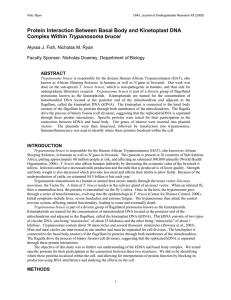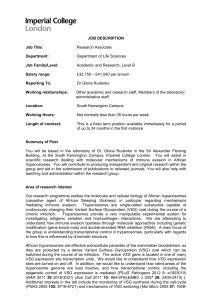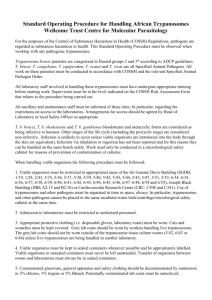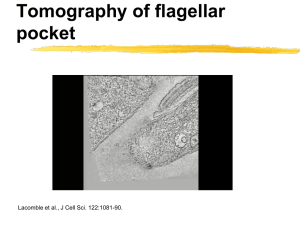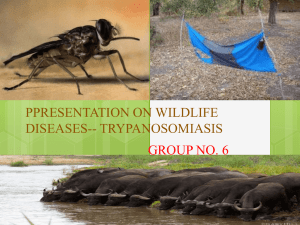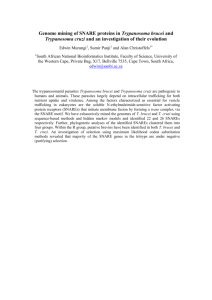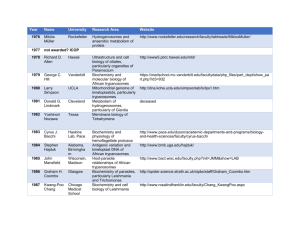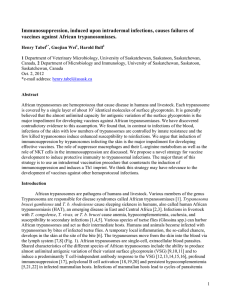XV. The Flagellates (Chapters 5 & 6) 2011 A. Hemoflagellates 1.
advertisement
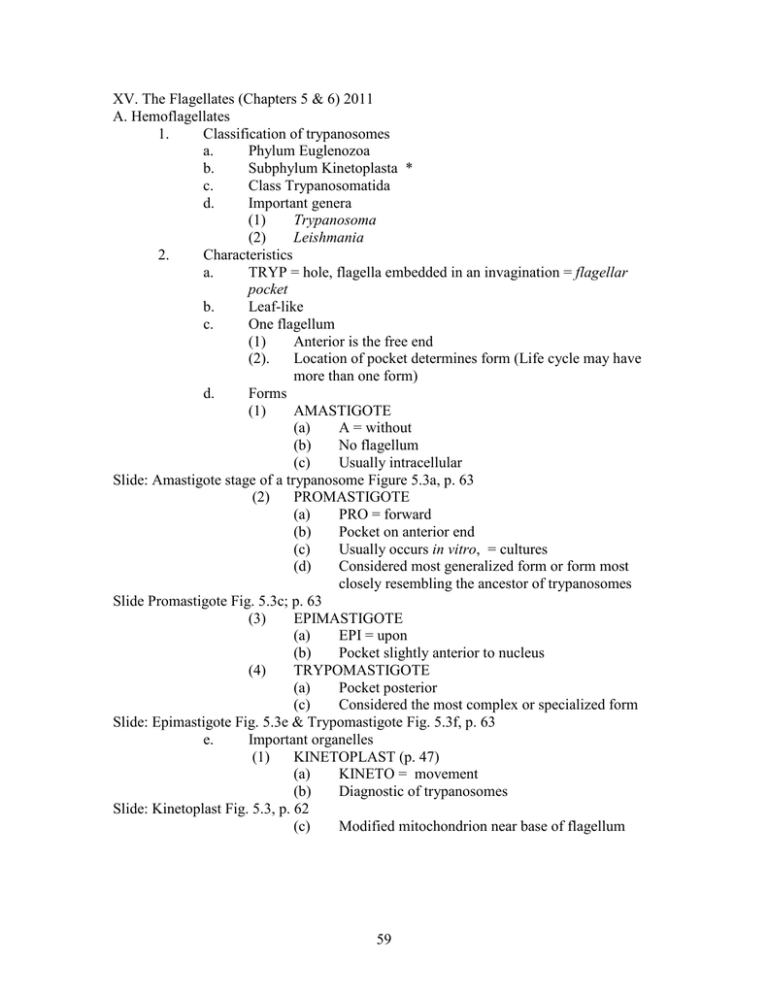
XV. The Flagellates (Chapters 5 & 6) 2011 A. Hemoflagellates 1. Classification of trypanosomes a. Phylum Euglenozoa b. Subphylum Kinetoplasta * c. Class Trypanosomatida d. Important genera (1) Trypanosoma (2) Leishmania 2. Characteristics a. TRYP = hole, flagella embedded in an invagination = flagellar pocket b. Leaf-like c. One flagellum (1) Anterior is the free end (2). Location of pocket determines form (Life cycle may have more than one form) d. Forms (1) AMASTIGOTE (a) A = without (b) No flagellum (c) Usually intracellular Slide: Amastigote stage of a trypanosome Figure 5.3a, p. 63 (2) PROMASTIGOTE (a) PRO = forward (b) Pocket on anterior end (c) Usually occurs in vitro, = cultures (d) Considered most generalized form or form most closely resembling the ancestor of trypanosomes Slide Promastigote Fig. 5.3c; p. 63 (3) EPIMASTIGOTE (a) EPI = upon (b) Pocket slightly anterior to nucleus (4) TRYPOMASTIGOTE (a) Pocket posterior (c) Considered the most complex or specialized form Slide: Epimastigote Fig. 5.3e & Trypomastigote Fig. 5.3f, p. 63 e. Important organelles (1) KINETOPLAST (p. 47) (a) KINETO = movement (b) Diagnostic of trypanosomes Slide: Kinetoplast Fig. 5.3, p. 62 (c) Modified mitochondrion near base of flagellum 59 Slide showing diagramic representation of a kinetoplast beginning to replicate (d) Contains a disk of circles of DNA (= kDNA) Slide showing mini- & maxi-circles of kinetoplast kDNA. (2) UNDULATING MEMBRANE (a) Membrane connecting most of flagellum to body; “sail” (b) Found on epimastigotes & trypomastigotes f. Methods used to infect hosts (1) SALIVARIAN trypanosomes [SALIVA = spit] (a) Develop in vector’s salivary glands (b) Accompany saliva into new host when vector bites (c) Example: Trypanosoma brucei “African sleeping sickness” (2) STERCORIAN trypanosomes [STERCUS = dung] (a) In vector’s intestine (b) Leave insect in feces (c) Invasion methods i Burrow through skin ii Enter bite lesion (d) Example: T. cruzi, “Chaga’s disease” 3. Trypanosomes that infect humans a. T. cruzi (pp 70-76) = Chagas disease (1) New World parasite (a) Kills 45,000 annually in Central & South America (b) 4 out of 500 people Rio Grande Valley, Texas (1980) (c) DNA detected in mummies from the Andes (oldest 4,000 years) (2) Reservoir hosts (a) Dogs & cats in Central America (b) Armadillos & opossums in Southern US (3) Vector = kissing bug, Family Reduviidae (a) During day in home wall crevices (b) Bites sleepers near mouth (c) Defecates when feeding (d) Victim scratches bite & smears trypanosomes in feces into eye or wound Slide: Chaga’s Disease Vector Rhodnius, The Kissing Bug; Found in crevices in homes, feeds at night; http://www.biosci.ohio-state.edu/~parasite/images.html Slide: Trypanosomes among blood cells; Natural History 1999, 108(1): 45 (4) Life-cycle in human (a) Mastigotes in blood (b) Amastigotes intracellular in muscle & reticuloendothelial cells = macrophages (c) Multiply in host cells (d) Escape host macrophages 60 (5) Pathology (a) Destroy cardiac muscle Slide: T. cruzi amastigotes, Heart tissue: http://www.biosci.ohio-state.edu/~parasite/images.html (b) Chronic infection (>20 years) results in megacolon or megaesophagus i Peristalsis of digestive tract ceases due to nerve damage ii Weak, flabby organ unable to pass material iii Diameter of digestive tract enlarges partly due to being filled by material Slide: Chagasic Esophagopathy, Fig. 5.12, p. 74 Slide: Archaeologist describes results from an autopsy of a 1,100 year-old male mummy from Mexico-Texas: Pringle, H. 1998, Discover, The Sickness of Mummies, p. 80 Slide: Cheap Thoughts by Jack O’Brien: Why Did the Europeans Who Explored Africa In the Eighteenth and Nineteenth Centuries Walk instead of Ride Horses? Slides: Paintings depicting exploration of American West b. T. brucei brucei, T. brucei gambiense, & T. brucei rhodesiense (pp 65-69) (1) “African sleeping sickness” (2) Vector (a) Tsetse flies (b) Glossina (Family Muscidae) (3) Hosts (a) Ungulate (= hoofed) mammals (b) Humans (4) Distribution (a) Central Africa (b) Historically large regions of Africa were sparsely settled because of T. brucei Slide: Distribution of sleeping sickness; Fig. 5.5, p. 66 Slide: Gary Larson on the tsetse fly Slide: Excerpt from Jared Diamond (1997) Guns, Germs, and Steel p. 400 discussing the impact of sleeping sickness on European colonization of Africa Slide: Excerpt from Frederick Cartwright (1972) Disease and History p. 138. quoting Livingston on the inability of raising horses in Africa due to sleeping sickness (5) Disease forms (a) Gambian or chronic form i Lasts years ii Circulatory, nervous, & lymphatic systems attacked iii Victim weak & sleepy iv Mortality high (b) Rhodesian or acute form i Death w/in a year ii Severe cardiac damage 61 iii Nervous & lymphatic systems not greatly affected c. Leishmania tropica ( = L. major) pp 79-81 (1) Many common names for condition (a) “Baghdad boil” (b) Medical term = cutaneous leishmaniasis (2) Found in Middle Eastern countries such as Kuwait, Iraq & Afghanistan (3) Vectors are sand flies = Phlebotomus (4) Infects skin (5) Not lethal (6) Difficult to spread from person to person Slide: “Baghdad Boil” or Cutaneous Leishmaniasis; http://health.yahoo.com/topic/skinconditions/overview/qanda/mayoclinic/86343C147E1F-47FD-A73C795D350CB5BE d. Leishmania donovani or visceral leishmaniasis (p. 82-85) (1) Kala-azar (2) Vectors are sand flies (3) Dogs are reservoir hosts (4) Asia, Africa, Central & South America (5) Tissues attacked (a) Reticuloendothelial cells (b) Spleen, liver & intestinal villi (6) Can be fatal 4. “Coat-of-many-colors” a. Vertebrate immune system (pp 25-35) (1) Cell surfaces coated with glycoproteins (= antigens) (2) B-cells make molecules (= antibodies) that bind to antigens on surfaces of foreign cells (3) Death of foreign cells (a) Antigen-antibody coating can kill foreign cells outright (b) Antigen-antibody coating marks cells for destruction by Killer T-cells (c) Process requires time b. Subversion of immune system by trypanosomes (1) Trypanosomes have many genes that code for surface proteins (variable surface glycoproteins = VSGs) (2) Host immune system will eventually eliminate most common strain (99% of trypanosome population) which bears VSG #1 (3) Surviving trypanosomes carry VSG #2 and their uninhibited reproduction results in a 2nd peak of infection (4) Host responds to VSG #2 strain (5) Cycle repeats until (a) Host is resistant to all VSGs 62 (b) Weakened host dies. B. Body cavity flagellates 1. Giardia intestinalis (= G. lamblia & G. intestinalis) a. Taxonomy (1) Phylum Retortamonada (2) Order Diplomonadida * (3) Family Hexamitidae b. Direct life-cycle c. Transmission usually occurs by drinking cysts d. Characteristics (1) Organelles give appearance of a face (a) Two nuclei = “eyes” (b) Two large endosomes (= nucleoli) = “pupils” (c) Four pairs of flagella = “hair” (d) Pair of dark-staining median bodies (unknown function) = “mouth” (2) Ventral adhesive disc Slide: Giardia intestinalis trophozoite, Fig. 6.5; p. 91 e. Found in small intestine of mammals (1) Attach to surface of epithelial cells in lumen (2) Physically interferes with ability of host cells to absorb nutrients by covering external surface of absorptive cells f. Pathology (1) Intestinal cramping (2) Diarrhea (3) Not fatal g. One of 10 most common human parasites h. Theories of Giardia‘s evolution (1) Until recently, it was thought that Giardia lacked mitochondria and that the ancestors of modern Giardia had split from the ancestral line of eukaryotes BEFORE the acquisition of mitochondria by endosymbiosis (2) MITOSOMES = small functional vestigial mitochondria were discovered in 2003 (3) Existence of mitosomes supports the hypothesis that… (a) …ancestors of Giardia had split from the other eukaryotes AFTER the acquisition of mitochondria and… (b) …LOST their mitochondria following the split Slide Tovar et al 2003, Title & Abstract, Nature 426: 172-176 2. Trichomonads a. Taxonomy (1) Phylum Axostylata (2) Order Trichomonadida (TRICHO = hair) (3) Family Trichomonadidae b. Characteristics 63 (1) PARABASAL BODY (a) Attached to kinetosomes of flagella (b) Homologous to Golgi apparatus (c) Sometimes wound around axostyle (d) Not homologous to kinetosome of trypanosomes (2) AXOSTYLE: Filament that passes through body projecting from the posterior (3) Several (3-5) flagella (4) An undulating membrane c. Trichomonas vaginalis (1) Transmitted sexually (2) Locations (a) Upper portion of vagina around cervix (b) Male urethra & prostate gland (3) Symptoms include white discharge (4) Morbidity of infant during childbirth Slide: Trichomonas vaginalis, Fig. 6.12b, p. 96 64
